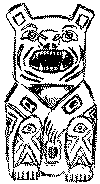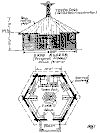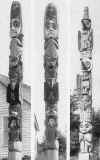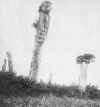By Robert De Groat
Headquarters
Headquarters is a dandy place for a pole or two to lend an outdoor atmosphere. The same is true of Local Council offices. Some towns having a Community Center or City Hall might appreciate a token or remembrance from the Scouts.
Mess Hall

The Dining Hall at Dan Beard's Outdoor School
A good place for some decoration is around the mantel near the fireplace. Another workable idea is to have a miniature camp totem pole with a flat base to set on the honor table. Possibly two other smaller poles for second and third place might also be carved.
Trading Post
This building is a vital part of every camp and affords excellent opportunity for decorations. At Dan Beard's camp the trading post is made of logs and is one of the central features as you enter the camp.
A few simple signs with an Indian head or animal totem go well as decoration to create the proper atmosphere.
Handicraft Lodge
Some camps include this as one of their features. It may be developed as described in the paragraphs on camp museum, headquarters, and trading posts. The illustration of the camp museum below serves to give a rough idea. In place of the exhibit space on the plan, benches and tool racks should be substituted.
 The
illustration shows a suggested totem for the celebration of the Mohawk Indian
Village at the Eastern States Exposition, illustrating the highlights of each
year in totem form. The story told by this pole, reading upwards, is as follows:
The
illustration shows a suggested totem for the celebration of the Mohawk Indian
Village at the Eastern States Exposition, illustrating the highlights of each
year in totem form. The story told by this pole, reading upwards, is as follows:
The village started from the ground (grass) in 1919 and had seen ten years of service (two red stripes). Springfield Council (S. C.) started the village and used a large sun umbrella with the words "Ask Me" on it. The village was actually built the following year, with longhouses as the feature. The next year Merit Badge booths were in evidence with everyone gazing at them (face and M.B.) Uncle Benny Hyde came up with his snakes from the American Museum of Natural History, and the Stamford Patrol broke a world's trek-cart record in the next two years. A tepee building contest came along, and then the Sea Scouts built the "Wasp." Harry Jordan came down from Maine and built the headquarters cabin. The next year the "Divisional" plan (different styles of tents) was the feature, and last year everybody was happy. The large "Y' stands for the tenth year and the Eagle f or the highest award of Scouting, the ambition of every Scout attending the village.
Camp Gateways
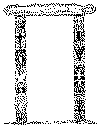
ENTRANCE POSTS AND CAMP GATEWAYS
Used as uprights with partial carving on them, poles make an unusual entrance and very attractive at that. It would be well for every camp to have an exceptional gateway or entrance, for, is it not true that when you enter someone's home you unconsciously form a rough picture in the back of your mind as to what the interior is like? That is something worth thinking about when you consider camp improvements.
Possibilities in the design would include the date of first year of the camp, one of the favorite legends or historical stories connected with the camp, or possibly some popular animal of the region-preferably an animal that is protected.
That would be following the true meaning of totemism-not molesting the animal totem. An eagle is a good symbol for the main feature, standing for the high ideals of the camp and for the Eagle Scout, the ambition of every camper.
Bulletin Boards
Frames with a little carving on them, touched off with a few bright colors, make a very distinctive bulletin board.
They may be lashed together with strands of heavy bark or they can form the frame for a stretched skin.
Ernest Thompson Seton in his book on Woodcraft mentions that the totem pole may be made wide and carved flat in a portion and used as an official camp bulletin board, anything appearing thereon having the same effect as if printed and distributed as a circular. It is the official news of camp.
The camp paper might have a post of its own. Surely every camp should have a paper, and if no photocopy machine is available, it is loads of fun to have one big paper which can be posted on the Camp Paper Totem Pole. Several fellows will always be found in camp who will undertake editing the paper.
Sign Posts
Sign posts with some simple carving on or near the top furnish a very effective way of decorating and giving a rustic touch to a camp. An arm may be stuck out at right angles with the directions or words lettered or carved therein. With a little originality any number of other designs can be developed for sign posts to help guide the new camper and visitor. It is better to have a little carving well done than an entire pole poorly executed.
Camp Museum
The above illustration shows a possible way of using a totem pole as the central feature and support of a small building. The rafter ends may be carved, as well as the corner supporting posts. This work has been done in the Totem Lodge of Camp Ski-Hut by Scout Hugh Davis.
In this building all the rafters are heavily spiked to the central pole. The roof should be heavily flashed with sheets of copper or sheet zinc where the pole joins the shingles or roofing material. This prevents leakage and eventual decay.
Council Ring
Opposite the Chief's seat in the Council Ring a huge totem pole should be placed. This gives dignity and solemnity to the ring and furnishes a pleasant background in the Scouts' memories of camp fires. Indian lore always appeals to the primitive urge in any live-blooded American boy.

EFFECTIVELY GROUPED POLES
OF THE NORTHWESTERN TRIBES
Several large camps in the east have used four poles, placed at the correct points of the four winds or cardinal compass points. This spacing of the poles gives a well balanced, symmetrical ring. In some of the Indian dances which will undoubtedly be staged at the pow-wows these four posts will fit in correctly with the ceremony of the four winds. The four compass points figure largely in adventuresome and exciting Indian stories which can be told in the ring.
A number of large Indian poles are clearly illustrated throughout the book which will furnish you with ideas and inspiration.
Ceremonial Ring
It is probably safe to say that every camp has a senior program of one kind or another. Indian backgrounds are included in a number of them.
The Chief's seat can be the central feature, while the points of the four winds may be the other subsidiary places. A very attractive entrance can be made, keeping the design simple and rustic. Many a fellow will feel pride in undertaking the leadership in building one part or another of the ring.
The seats may be made of heavy logs, as stone retains the cold and dampness. By correct blocking the seats may be raised a few inches above the ground to prevent damp-rot and to allow the sun and breezes to penetrate the log seats.
Leader's or Campmaster's Den
A large number of useful articles can be carved that will delight the heart of any Leader. His den is generally his paradise and he decorates it as he likes. A piece of Indian carving should grace one part or another of his lodge, den or tent.

FOR YOUR LEADER'S DEN
Very often a Scout or group of Scouts would like to give their leader a small remembrance of his services-a gift for his birthday, or something of the kind. Any number of objects mentioned in this book would please your leader, for after all, it is not the value of the gift but the spirit and feeling in which it is given that count. The Leader can look back and say proudly, "Look at this ash tray-Bobby Jones, an old camp pal of mine, made that!"
Try it some time and watch the look in your Leader's eyes. See if they don't sparkle just a little brighter.
Weather Vanes
By carving a shallow design and using thin wood, you can make a very unusual weather vane. Cedar and cypress wood have the best weathering qualities. It is best to use a good strong outline to produce a pleasing silhouette. Colors fade very rapidly in a short while, so that bright primary colors should be used.
Miscellaneous Objects

Headdress made from cedar slab
ird houses, supports for bird houses or bird baths, stands for table lamps, markers on the highway to the camp site, around the camp or at historic spots, rural free delivery letter boxes and garden decorations are a few of the things that may be developed under this heading.
Headquarters Building and Interior Decorations

SCOUT MEETING ROOM WITH TOTEM CORNER
POSTS AND TROOP TOTEM OVER FIRE PLACE
Dan Beard, in his book, "Shelters, Shacks and Shanties," includes several ideas on carving the ends of the main or corner rafters. The interior beams can also be carved as ornamental features. The beam over the main part of the fireplace may have a few designs in bas-relief on it.
In the construction of the building, corner posts sometimes are used by lumbermen instead of notching the logs. In the Totem Lodge of Camp Ski-Hi, Scout Hugh Davis has done some notable carving. The lodge is hexagonal and each one of the six corner posts has a short story on it. This can be applied to any other building of a similar nature.
Nothing could be more accurate and correct historically than to have the main beams carved. In the earliest days of Babylonia and Assyria, beams were carved. Thenceforth down through the ages the different peoples and styles of architecture have adopted to some extent the carved beam or coffered ceiling.
Indian Village Longhouse
Numerous camps are including Indian work as a big feature of their program, realizing that all fellows like the wild, primitive strength and high ideals of the early Indian.

Model of front of Alaskan Indian lodge
According to Ernest Thompson Seton and other noted authorities, the Indian, in his wild surroundings, was physically and spiritually the most perfect person known in history.
Camp Directors are realizing the endless possibilities for camp fires, pageants, ceremonials and crafts which can and are being developed through Indian lore.
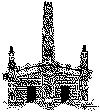
Actual Model from the Haidas
Thus, as the demand for Indian lore increases, camps are buying tepees, paying fine salaries to Indian instructors in craft and dance work and are placing it in the foreground of camp fire programs. Some camps have built special lodges and wigwams for the promotion of craft work, used as a place to do craftwork in rainy weather, a place to hold big pow-wows or meetings of advanced groups in rainy or cold weather, or it may be used for displays.
